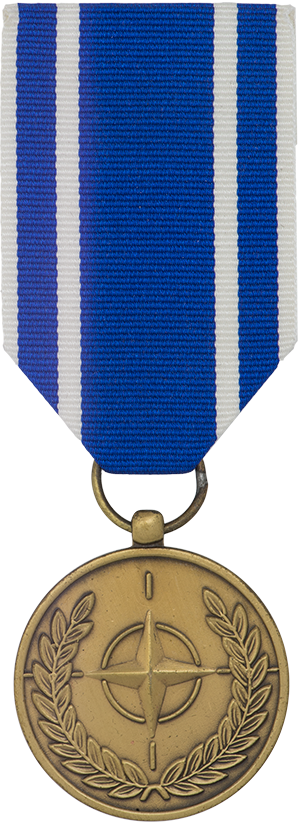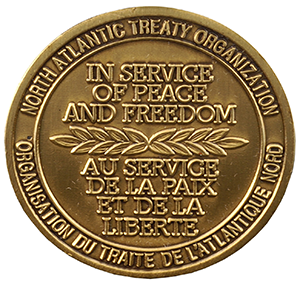NATO Medal for the Former Yugoslav Republic of Macedonia (NATO-FYROM)
The official description, eligibility, criteria, and history of the NATO Medal for the Former Yugoslav Republic of Macedonia (NATO-FYROM).


Context
Insurgents agreed to the weapons collection plan and to voluntarily hand in their weapons. Part of this plan was a list of weapons and ammunition which the insurgents committed to provide as one of their obligations as a confidence-building measure and one element of a broader peace plan proposed by President Trajkovski. TFH accepted what was passed in within the established timeframe. In accordance with the agreement between the ethnic Albanian insurgents and the government of the former Yugoslav Republic of MacedoniaFootnote 1, it was the responsibility of the insurgents to de-mine weapons caches and bring any hidden weapons to the collection sites. TFH’s only mandate was to collect weapons that were voluntarily turned in by the armed extremists; the responsibility to ensure a safe and secure environment remained with the government of the former Yugoslav Republic of Macedonia.
Eligibility and criteria
Awarded for twenty five days continuous or accumulated service on the land, or in the air space of former Yugoslav Republic of Macedonia for service time that includes dates between:
- 1 June 2001 and 27 August 2001, during the period prior to OP ESSENTIAL HARVEST and between; and
- 27 August 2001 and 27 September 2001, during the period of OP ESSENTIAL HARVEST.
Awarded for thirty days continuous or accumulated service on the land, or in the air space of former Yugoslav Republic of Macedonia between 27 September 2001 and 31 December 2002.
This medal was replaced by the Non-Article 5 NATO Medal for Operations in the Balkans on 1 January 2003.
Personnel arriving in theatre before 3 December 2002 count their time towards this medal and its associated tour numerals until the end of the deployment. Personnel arriving in-theatre on or after 3 December 2002 count their time towards the Non-Article 5 NATO Medal for Operations in the Balkans. No personnel can receive the two medals for the same deployment regardless of its duration.
NATO strictly applies their medals policy and will not consider requests for initial issue of NATO medals that are submitted more than two years after repatriation from mission area.
NATO Regulations state that any person who dies or is evacuated because of injuries of medical reasons directly attributable to service is deemed to have satisfied the time criteria.
Description
The Medal is circular in form and made of bronze, and bearing:
- On the obverse, the NATO star set in a wreath of olive leaves; and
- On the reverse, the title "NORTH ATLANTIC TREATY ORGANIZATION" and the words "IN SERVICE OF PEACE AND FREEDOM" in English and French.
A 12mm bronze ring, which holds the ribbon, passes through a small hollow ball at the top of a claw joined to the top of the medal.
The ribbon is dark blue, the colour of NATO with four white stripes, two on either end, representing peace.
The tour numerals are Arabic script and made of bronze.
Bar(s)
There is no bar to this medal.
Wearing
The medal shall be worn in sequence prescribed in the Canadian Orders, Decorations and Medals Directive, and in the following manner: on the left breast, suspended from the ribbon described above, after the NATO KOSOVO medal and before the NATO ARTICLE FIVE medal for OP EAGLE ASSIST medal.
Post-nominals
The use of a post-nominal is not authorized for this medal.
Historical notes
The medal is accompanied by a certificate.